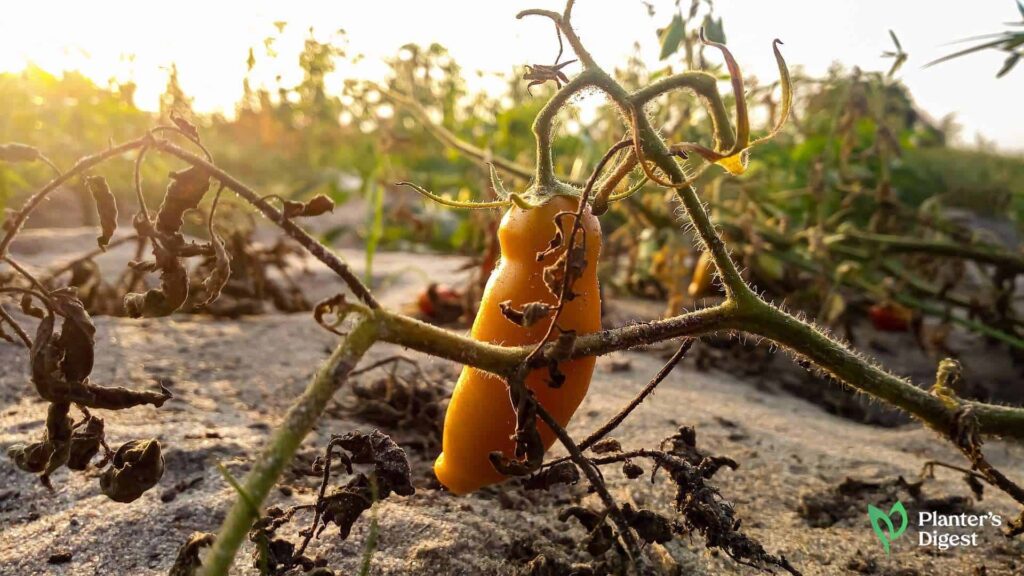
Do you see any discoloration from your green tomato stem? Afraid that this is the end of your tomato plant?
Fear not – it doesn’t need to be! That’s because we’ll help you diagnose what stem problem your tomato plant is suffering from and how to fix it.
Common Tomato Stem Problems
The nine most common tomato stem problems are bacterial spots, lesions, Didymella stem rot, bumps, white spots, stem cracking, Fusarium wilts, gray mold, and Southern blight.
Let’s get into these tomato stem problems one by one and how to address them.
1. Bacterial Spots
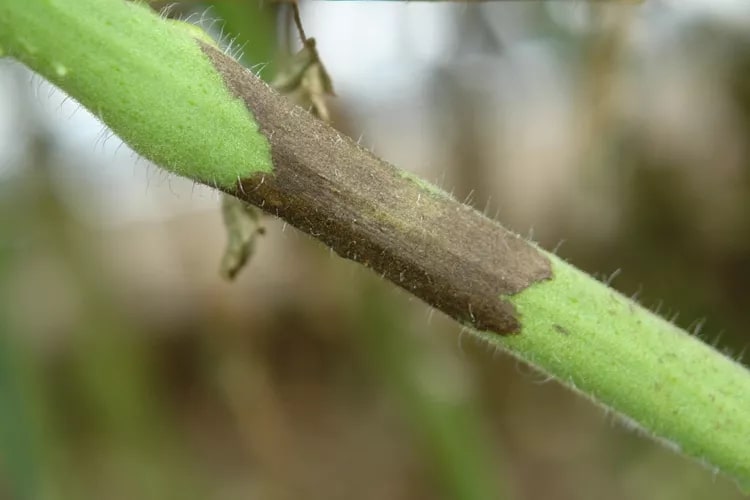
| Cause/s | • Early or late blight • Alternaria solani |
| Symptom/s | Black or brown spots |
| Treatment / Prevention | • Remove infected stems or tomato plant • Fungicide |
Dark spots are easily seen on green tomato stems. When you see them, it’s normal to panic, thinking that your plant is already beginning to rot.
Two possible causes of these dark spots are an early or late blight.
Early blight is caused by the fungus Alternaria solani. They produce brown or black spots on the stem just above the soil.
Late blight, on the other hand, is an ominous sign. Your tomato plant is dying when you see dark black to purple spots spread through the stem and leaves.
These dark spots or lesions cause the death of the leaves and stem and the collapse of the entire plant.
If you’re growing your tomato plant outside, be more vigilant against late blight because it’s more common outdoors than those grown in greenhouses.
| How To Fix • Keep the leaves dry and apply a fungicide. Fungi causing early and late blight thrive in wet or moist leaves. Keeping tomato leaves dry, especially those at the base of the plant, will prevent them from becoming breeding grounds for pathogens. Applying fungicide will also keep the surface of the leaves inhabitable for fungi. Protect the tomato plant by spraying fungicide every 7 to 10 days. |
2. Lesions on Stems
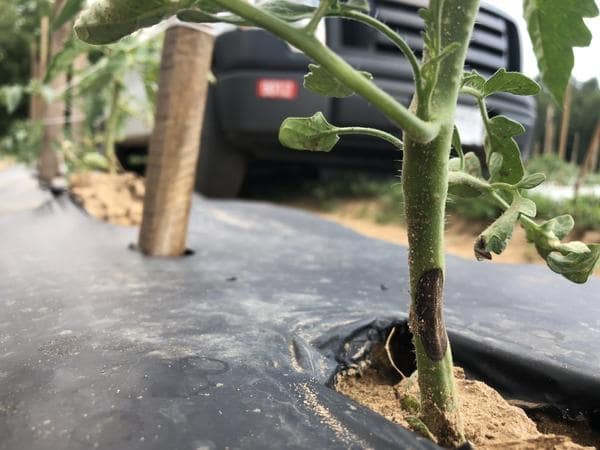
| Cause/s | • Alternaria stem canker • Bacterial canker |
| Symptom/s | • Enlarges stem rings • Brown spots or streaks in lesions |
| Treatment / Prevention | • Remove tomato plant • Use disease-resistant tomato varieties |
If you see enlarged stem rings with brown lesions, your tomato stem is infected with the Alternaria stem canker.
These dark brown cankers usually begin to form along the plant stem. It enlarges the stem rings outwards, making it visible to the eye.
| How To Fix • Remove the infected tomato plant. Bacterial canker is incurable, so plant removal aims to protect the pathogen from spreading to other plants. Once you discover your plant is suffering from bacterial canker, immediately remove the plant from your garden. • Consider disease-resistant tomato cultivars in the next planting season. (See common disease-resistant tomato varieties in the FAQs.) |
3. Didymella Stem Rot
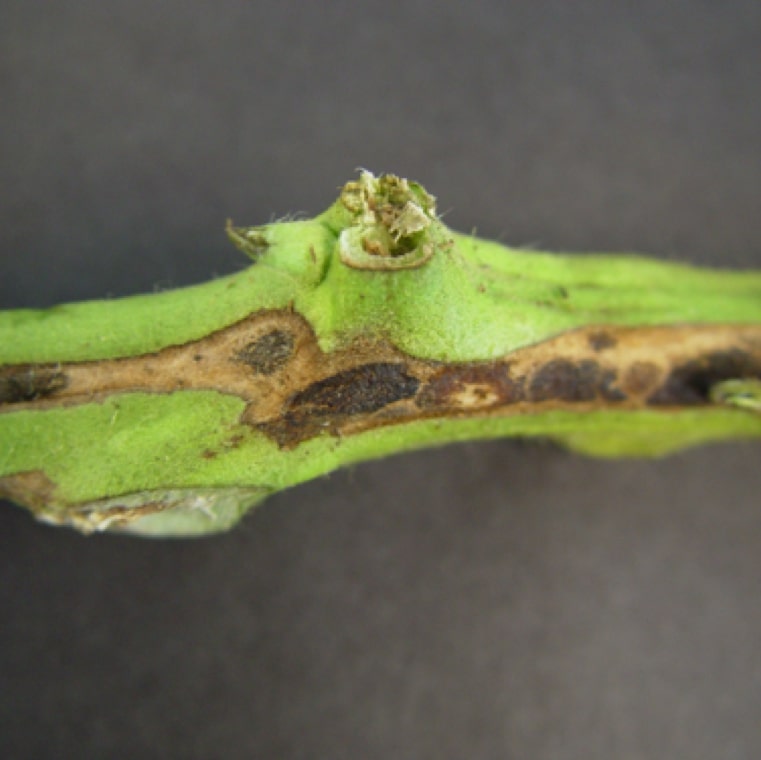
| Cause/s | Didymella lycopersici |
| Symptom/s | Brown rotted patches |
| Treatment | Remove tomato plant |
When your tomato stem has brown rot patches, it’s infected with the Didymella stem rot.
Your tomato plant most likely got infected by the Didymella lycopersici that’s present in your garden soil.
This fungus thrives in temperature that reaches up to 60°F (15°C). They also reproduce in soils that are lacking in nitrogen and phosphorus content.
These fungi affect your tomato plant’s stems, leaves, and fruits.
At first, dark brown sunken lesions will appear at the bottom of the stem near the soil line. Then, this lesion will expand to the girdle until it moves upward to infect the plant’s leaves and fruits.
Unfortunately, watering the plants will help spread the fungal spores throughout the plant.
Expect the leaves to turn yellow and the fruits to have sunken black spots.
| How To Fix • Remove the infested tomato plant and its soil. • Avoid planting tomatoes with other host plants of the fungi like eggplant, pepper, and potato. This will reduce the disease risk for at least three years. • Maintain proper temperature and humidity. Keep a temperature above 60°F (15°C) and the humidity below 90% for tomato plants grown indoors or in greenhouses. |
4. Bumps on Stems
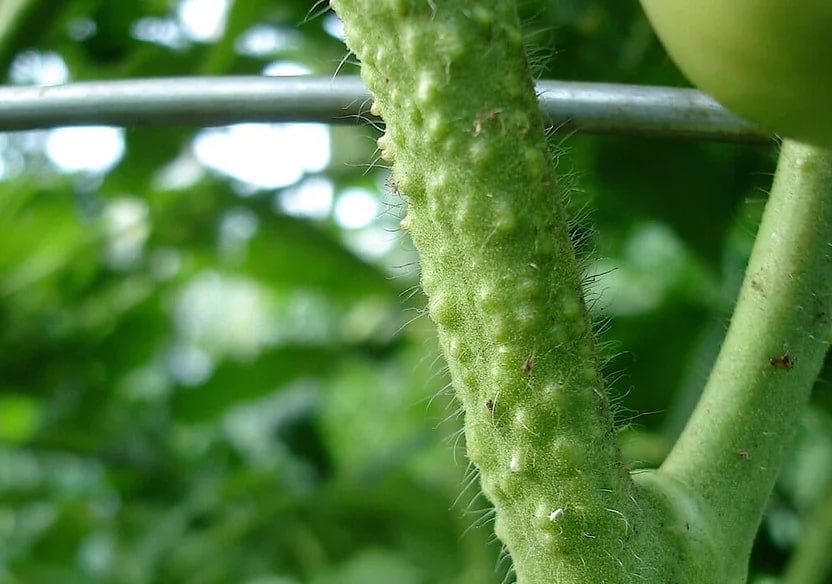
| Cause/s | • Root initials • Overwatering • Herbicide exposure • Tomato Stem Primordia |
| Symptom/s | White or brown bumps on stem |
| Treatment / Prevention | • Improve soil humidity • Have a proper drainage system • Observe proper spacing between plants |
When tomato plants get stressed, they tend to develop small white, brown, or green bumps on their stems. The good news is that this shouldn’t be a cause for alarm for a plant owner like you.
These bumps are actually called root initials. They’re nodules that emerge along the stem where the plant would produce roots if it were below the soil.
The most common cause of stem bumps is overwatering. A blockage in the internal plant transport system causes the root initials to emerge.
Tomato plants grow well when watered early in the morning, getting 1 inch of water every week. Exceeding this amount, the plant is at high risk for overwatering.
Another reason for the emergence of these bumps is herbicides. After exposure, you’ll see these bumps on the stem and the leaves of the tomato plant curling inwards.
The tomato plant will generally heal these stem bumps once its growing conditions improve.
| How To Fix • Enhance soil humidity. Tomato plants grow best when the relative humidity is between 65% and 85%. Add a layer of mulch to keep the moisture in the soil. • Provide a proper drainage system and spacing between plants. Add holes at the bottom of the container to drain excess water. It’s advisable to place drainage material like gravel at the bottom of the pot before adding soil so the roots will not drown. Tomato plants should also be placed at least 2 to 3 feet apart. |
5. White Spots
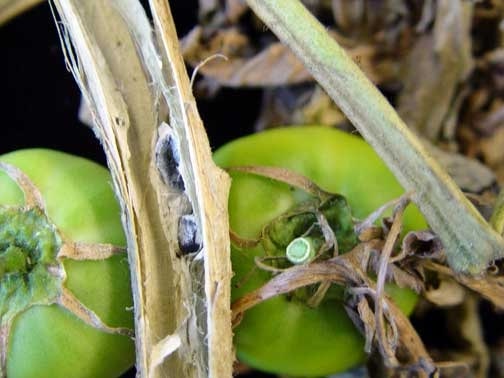
| Cause/s | • Powdery mildew • Timber rot Sclerotinia stem rot • Inadequate aeration |
| Symptom/s | White spots with fluffy mold |
| Treatment / Prevention | • Remove the tomato plant • Sanitize gardening tools • Observe proper plant spacing |
White spots are equally alarming as the dark spots from late blight. Only this time, the disease is caused by sclerotinia stem rot or more commonly known as timber rot.
With this disease, the tomato stems develop white fluffy, moldy lesions at the bottom of the plant. The soft wet rot that forms on the stems will cause the plant to collapse.
Cold, wet conditions and inadequate air circulation around the tomato plant cause the spread of this fungal disease.
As it spreads, the tomato plant and its leaves will turn yellow, wilt, and collapse altogether.
| How To Fix • Immediately uproot the plant and replace your garden soil. The fungi can quickly spread to the rest of your garden plants and stay in your soil for ten years. • Don’t reuse the infected soil as compost. Not even the high temperature of domestic compost heaps can kill the fungi sclerotinia. • Always sanitize your gardening tools. This will prevent timber rot in the future. • Provide proper spacing between plants for adequate aeration and drainage. |
6. Stem Cracking
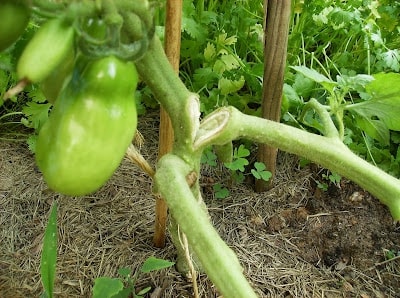
| Cause/s | • Wind • Overwatering |
| Symptom/s | • Cracked stems • Vertically-split stems |
| Treatment | • Strong support structure • Pruning |
Did you wake up to cracked and broken stems in your garden? Well, strong winds are most likely the culprit for this problem.
Tomato plants usually need a sturdy structure to support their weight of the plant. When they cannot lean on these structures coupled with strong winds, their stems will most likely snap and fall over.
Cracked stems are also caused by overwatering. If there’s too much water absorbed by the stem, they’ll split open vertically.
On the brighter side, the tomato plant can repair its split or cracked stem independently over time.
| How To Fix • Re-attach the plant in a stronger upright structure. • Prune the fruitless stem once cracks appear. |
7. Fusarium wilts
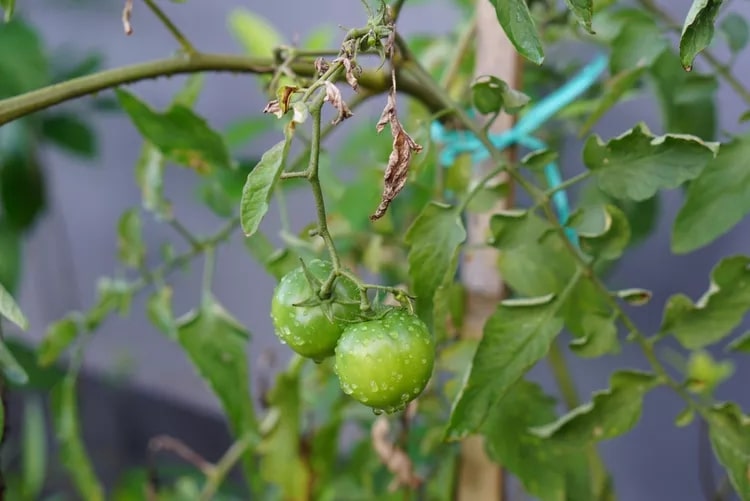
| Cause/s | Fusarium oxysporum |
| Symptom/s | Stem decay |
| Treatment / Prevention | • Remove tomato plant • Use Fusarium-resistant varieties |
Fusarium wilt is another soil-borne disease caused by the fungi Fusarium oxysporum. This fungus causes blackened and rotten stem bases in tomato plants.
After infecting the stem bases, the Fusarium will develop orange, pink, or white fungal growth on the affected stems. They reproduce more quickly in wet conditions.
The Fusarium wilt disease does not only affect the tomato stems. It stunts the plant’s overall growth and causes its leaves to turn yellow and wilt away.
| How To Fix • Remove the infected tomato plant as soon as possible. • Replace the contaminated soil. The fungi can stay there for at least 4 to 5 years. • Use Fusarium-resistant varieties. Some Fusarium-resistant tomato varieties are the Florida 7514, Neptune, and Tropic Boy tomatoes. • Graft Fusarium-resistant rootstock with the tomato stem. Use a rootstock resistant to Fusarium wilt and graft it with a scion of the tomato plant to increase resistance. Some tomato varieties that can be used as rootstock are the Bowman, Estamino, Maxifort, and Shin Cheong Gang tomatoes. |
8. Gray mold
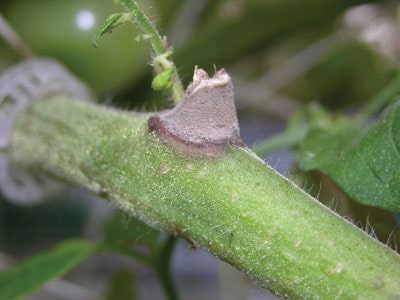
| Cause/s | Botrytis cinerea |
| Symptom/s | Fuzzy gray mold in the stem |
| Treatment / Prevention | • Remove tomato plant • Avoid overcrowding plants • Improve ventilation |
The gray mold that you see developing on your tomato stems are caused by the fungus Botrytis cinerea.
This plant disease targets wounded or stressed tomato plants. They spread fast under humid conditions and are present all throughout the year.
The gray mold moves from the stem to the leaves, buds, and flowers up to the fruit of the plan, causing them to wither and die slowly but surely.
| How To Fix • Remove dead leaves, buds, and flowers. When you see the gray mold spreading on your tomato plant, waste no time and remove the dead leaves, buds, and flowers. • Dispose of infected plant parts. Don’t leave the plant debris lying on the ground to stop the spread of the fungi through the soil. • Reduce the humidity on the tomato plant. Prune the tomato plant regularly and place them 2 to 3 feet apart in your garden. |
9. Southern Blight
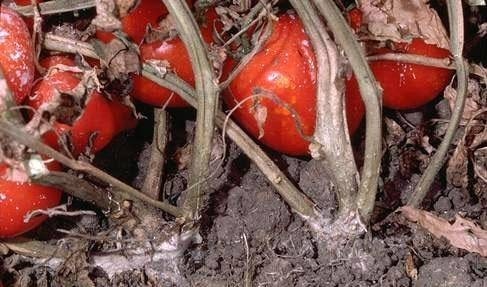
| Cause/s | Sclerotium rolfsii |
| Symptom/s | White filaments at the bottom of the stem |
| Treatment / Prevention | • Remove tomato plant • Use disease-resistant tomato varieties |
Last on our list is the Southern blight disease. This is a soil-borne fungal problem brought by Sclerotium rolfsii.
At the bottom of the lower stem, you’ll see a network of white filaments called mycelium. They cause the stem to rot and the tomato plant to wilt and die.
The Southern blight disease loves warm, humid weather and can stay in the soil for around four years. It’s a common problem for non-commercial tomato growers.
| How To Fix • Remove the infected tomato plant, including its soil. • Using disease-resistant tomato varieties. (See common disease-resistant tomato varieties in the FAQs.) |
FAQs on Tomato Stem Problems
The most common disease-resistant tomato varieties are
• Big Daddy Tomatoes
• Southern Star Tomatoes
• Early Girl Tomatoes
• Plum Perfect Tomatoes
• Summer Sweetheart Tomatoes
• Porterhouse Tomatoes
• Brandy Wise Tomatoes
• Stellar Tomatoes
• Iron Lady Tomatoes
• Rutgers Tomatoes
• Sweet Seedless Tomatoes
• Summer Girl Tomatoes
• Italian Ice Tomatoes
• Supersteak Tomatoes
• Sungold Tomatoes
• Burpee Tomatoes
• Super Sauce Tomatoes
• Better Bush Tomatoes
• Yellow PearTomatoes
• Better Boy Tomatoes
Keep the stems and leaves of the tomato plant dry to avoid stem rot. This prevents the cultivation and entry of fungi, bacteria and viral diseases to the tomato plant.
Tomato stems die because of overwatering and infection by fungal, viral, and bacterial diseases.
Save the dying tomato stem by transplanting the tomato plant. The plant will get a fresh source of nutrients from the soil, water, and enough sunlight in the new location.
A tomato plant can heal its broken stem independently. Attach the cracked stem to the secured and sturdy structure, and connect them with twine; the stem will heal over time.




